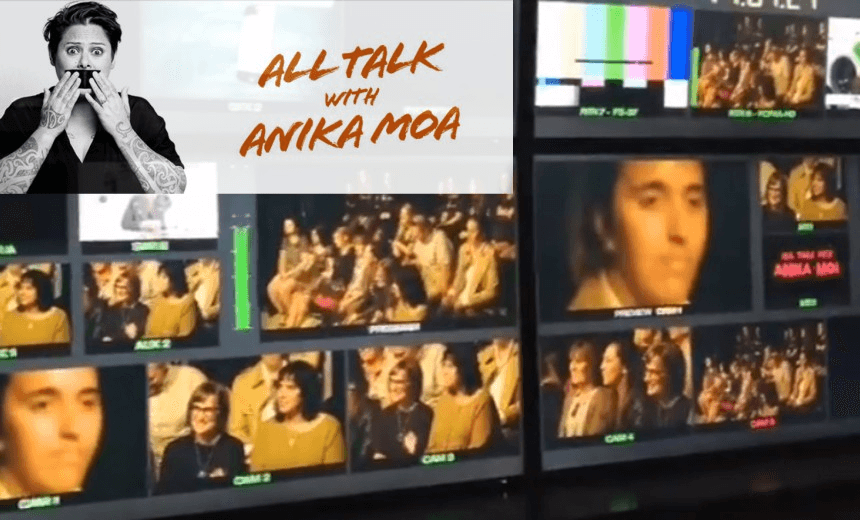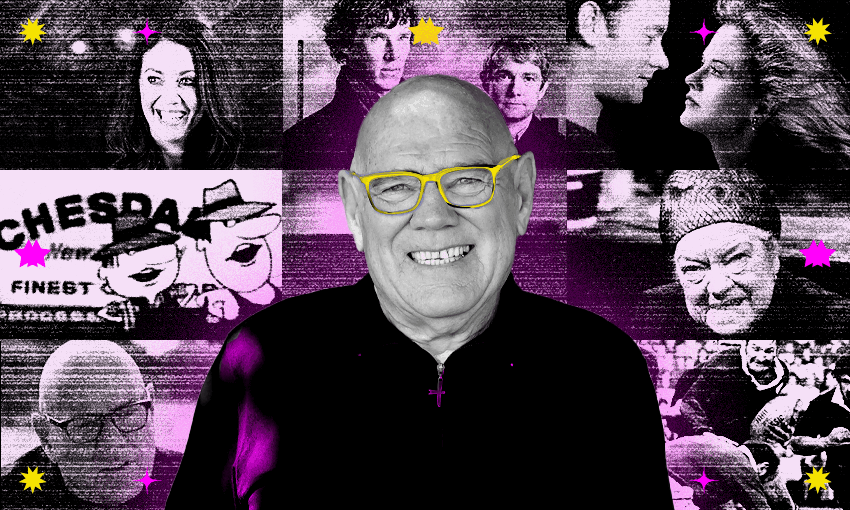Season two of All Talk With Anika Moa premieres tonight on Māori Television. Madeleine Chapman attended the taping and was transformed into a star.
The studio audience wasn’t big. In fact, it took me just a few seconds to count 19 bodies total, including me. I knew the audience for All Talk With Anika Moa would be small but the reality of it chilled me to the core. Because 19 audience members meant one thing to me and one thing only. I was going to be on TV. I really didn’t want to be on TV.
I’d seen enough American talk shows to incorrectly assume that it would be possible to hide within a studio audience. When I looked behind me and saw a group of young dancers, probably no older than 12, I knew at once that I’d be appearing in a starring role on this episode. How could I predict the future? Because I’ve seen the show before and the funniest (read: most inappropriate) parts don’t exactly call for a cutaway to an innocent cherub looking confused in the audience.
Once we’d all filed in, the stage manager rearranged us so that there were no gaps in the audience shots. Then he had us clap, and clap, and clap.
“Alright, now we’re going to get some laughing shots.”
Now wait one goddamn minute. Nobody had mentioned any acting. I can barely fake laugh to someone I’ve just met, let alone do it convincingly on camera. My palms started sweating, my knees went weak, my arms grew heavy and so on…spaghetti.
So we laughed and laughed and laughed while inside I cried and cried and cried. The cameras, they’re so close. I wouldn’t wish it on my worst enemy.
By the time Anika herself walked onto set, I was exhausted. My cheeks hurt from the pain of forced laughter and I wondered if I’d ever smile again. But I did, because Anika’s hilarious. Right away, she spotted the young girls sitting behind me and looked surprised. “Oh we have young people. I’ll try not to swear,” she said, addressing us directly. “But let’s be honest, you’re shit out of luck.”
And that was that. What followed was two hours of genuine laughter at puns, swearing, and increasingly sexual humour. Top of the guest list was Rose Matafeo, introduced with a rare correct pronunciation of her last name. When she was then made to introduce herself, she instinctively pronounced it ‘wrong’ (how most people say it). It reminded me of the fact that until very recently I pronounced my own mum’s name wrong because I grew up in a predominantly white neighbourhood and only ever heard her introducing herself to white people. Something tells me “Rose Ma-ta-feh-or” might only ever exist on Māori television. Note: ‘feh’ rhymes with ‘meh’.
Each interview segment began slowly (much like any conversation), got really good in the middle, then fizzled out at the end (much like any conversation). With introductions being essential to a talk show, I soon realised that often the funniest moments in a taping don’t make it to air. I certainly didn’t envy whoever’s job it would be to edit the two+ hours of footage into a svelte 40 minute show.
Related:
Alex Casey: Anika Moa continues to give no fucks in a Ponsonby cafe
At one point, Moa played a game with Matafeo and Cohen Holloway (very good at impressions and also the second guest) that involved impersonating a celebrity orgasming. It was a good, though long, bit that would most certainly be cut down and play better on TV.
If they had recorded our reactions live, you’d be forgiven for thinking you’d sat on the remote and changed the channel to Spongebob Squarepants because for that segment I transformed into Mr Krabs. As each joke got more raunchy, I could hear the girls behind me go from quiet giggling to complete silence, either from confusion or embarrassment, and I was, well, shook. I wondered which adult was supervising them and what the conversation would be on the car ride home.
The show wrapped up with a truly impressive live performance from Stan Walker that required just the one take and was definitely worth witnessing in person. As I exited the studio and accidentally looked directly into the sun, I tried to imagine how the edited episode would play out. In all my imaginings, I once again forgot to entertain the possibility of myself appearing on screen.
Later that day I watched Anika Moa’s Instagram story which included shots of filming, and then shots of the editing room. There I was, in a wide shot on one screen, and in a scary close up on another. I looked like I was genuinely laughing. It didn’t look so bad. In fact I could almost live with it. Then the camera stayed zoomed in on my face as I turned my head.
In that moment, alone in her room, a young woman caught the side profile of her face for perhaps the first time in her life, and quietly wept.
Want to experience similar fame on a Friday afternoon? Email nikau@rogueproductions.co.nz for info on future tapings.
All Talk With Anika Moa returns to Māori TV on Wednesday at 9.30pm.



